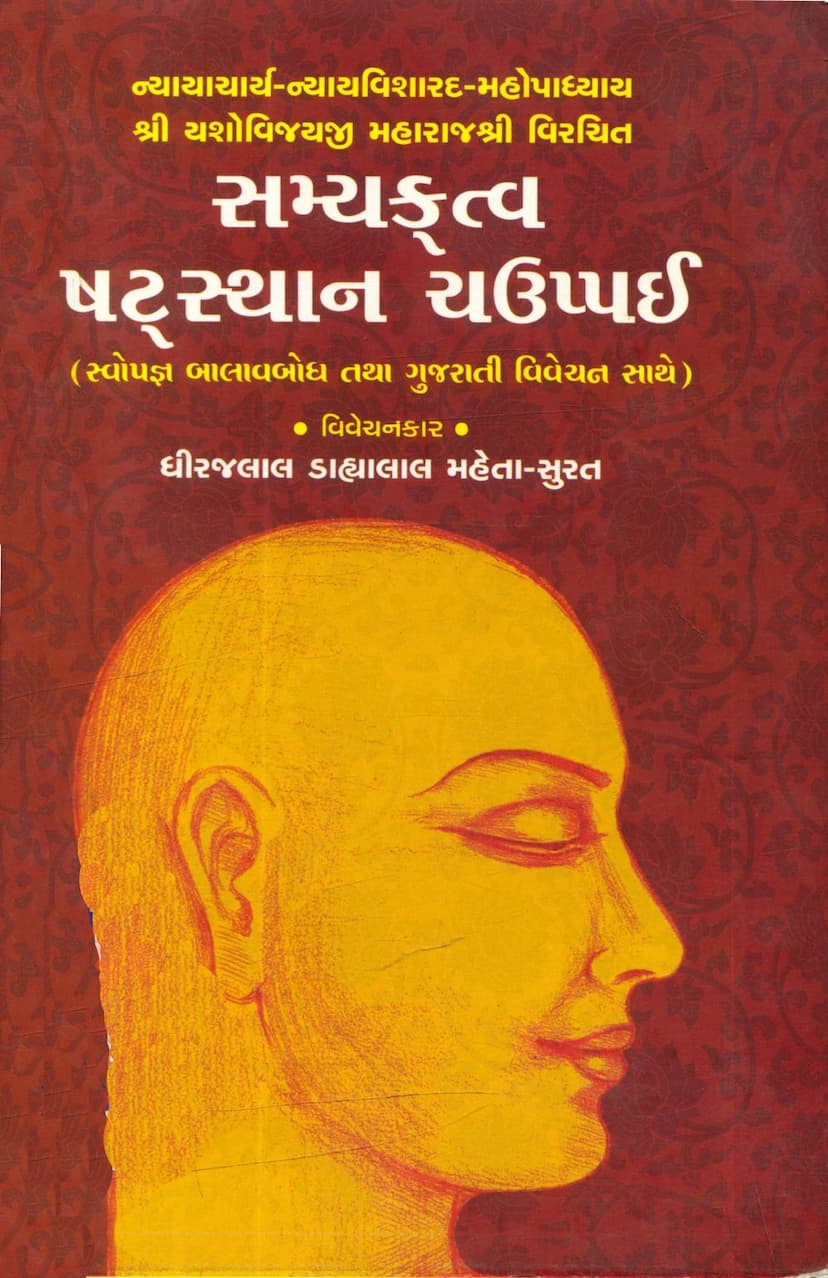Samyaktva Shatsthan Chauppai
Added to library: September 2, 2025

Summary
Summary of "Samyaktva Shasthan Chauppai" by Upadhyay Yashovijayji, with Commentary by Dhirajlal Dahyalal Mehta
This comprehensive Jain text, "Samyaktva Shasthan Chauppai" (The Six Positions of Right Faith), originally authored by the esteemed scholar Upadhyay Yashovijayji, is presented here with a detailed Gujarati commentary by Dhirajlal Dahyalal Mehta. The work delves into the fundamental principles of Jainism, specifically focusing on the concept of "Samyaktva" (Right Faith) and its six crucial stages or positions, critically examining and refuting various non-Jain philosophical viewpoints through reasoned argumentation.
Core Theme: The Six Positions of Right Faith and Refutation of Opposing Views
The central purpose of this text is to elucidate the six essential positions that constitute true Right Faith (Samyaktva) in Jainism. These six positions are identified as:
- The existence of the soul (Ātmā): Affirming the reality of the soul as a distinct entity from the body.
- The eternality of the soul: Asserting that the soul is permanent and unchanging in its essence.
- The soul as the doer of actions (Karta): Establishing that the soul is the agent responsible for its actions.
- The soul as the enjoyer of actions (Bhakta): Proving that the soul experiences the consequences of its actions.
- The existence of liberation (Moksha): Affirming that liberation from the cycle of birth and death is attainable.
- The existence of the means to liberation (Moksha Upay): Confirming that there are practical methods and principles to achieve liberation.
The author, Upadhyay Yashovijayji, a profound scholar of various philosophical schools, meticulously refutes the doctrines of six prominent non-Jain philosophical traditions:
- Charvaka: Denying the existence of the soul and asserting that consciousness arises from material elements.
- Buddhism: Proposing that the soul is momentary and impermanent, a stream of consciousness.
- Vedanta: Asserting the non-dualistic nature of reality, often merging the soul with Brahman, and sometimes misinterpreting the soul's nature.
- Samkhya: Viewing the soul as passive and devoid of agency, with Prakriti (matter) being the active principle and consciousness merely a reflection.
- Mimansak: Focusing on ritualistic actions and Vedic injunctions as the primary means to salvation, often overlooking the soul's inherent nature.
- Tarkika (Naiyayikas): Primarily focused on logic and debate, sometimes leading to rigid and absolutist views.
The text systematically presents the arguments of these opposing schools (Purvapaksha) and then rigorously refutes them with sharp logic and philosophical reasoning (Uttarapaksha), thereby establishing the truth of the Jain perspective.
Commentary by Dhirajlal Dahyalal Mehta
The Gujarati commentary by Dhirajlal Dahyalal Mehta serves as an invaluable aid to understanding this complex philosophical treatise. Mehta's commentary breaks down the intricate arguments of Upadhyay Yashovijayji into easily comprehensible language, providing further explanations, clarifications, and contextual information. His detailed exposition makes the profound teachings accessible to a wider audience, ensuring that the essence of the original text is preserved while enhancing its readability.
Key Aspects Highlighted:
- The Supremacy of Samyaktva: The text emphasizes that Samyaktva is the foundational virtue, akin to the number 'one' in mathematics, while other virtues are like 'zeros' that gain value only in the presence of 'one'. Without Samyaktva, even knowledge and conduct can lead to ego and ultimately harm the soul.
- Refutation of Extremism (Ekantavada): A significant portion of the work is dedicated to dismantling one-sided or absolute views (Ekantavada) prevalent in other philosophies. The commentary highlights how Jainism, with its anekantavada (theory of manifold aspects), embraces a relative and contextual understanding of reality, which is crucial for true Samyaktva.
- The Role of Reason and Logic: The text showcases the power of reason and logic within Jain philosophy, as Upadhyay Yashovijayji, a renowned logician, uses sharp arguments to dismantle opposing views.
- The Author's Life and Legacy: The introductory pages provide a biographical sketch of Acharya Ashokasagar Surishwarji, highlighting his spiritual journey, his prolific literary contributions, and his dedication to propagating Jain teachings. This context adds a layer of appreciation for the work's origin and its author's devotion.
- The Importance of Gujarati Language: The commentary and the original work's translation into Gujarati are noted as a significant contribution, making profound philosophical concepts accessible to the Gujarati-speaking populace, thereby fostering wider religious education.
Conclusion:
"Samyaktva Shasthan Chauppai," with its insightful commentary, stands as a seminal work in Jain philosophy. It not only meticulously lays out the six core tenets of Right Faith but also serves as a powerful defense of Jain principles against other philosophical systems. The text is a testament to the intellectual rigor and philosophical depth of Jain tradition, making it an essential read for anyone seeking to understand the foundational aspects of Jainism and its dialectical approach to truth.